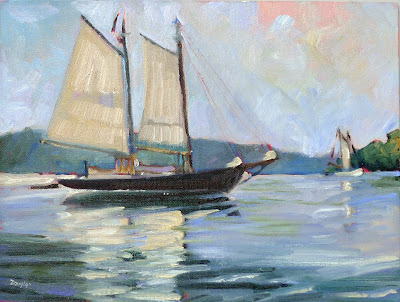She’s a long, lean dash of black in the water, but up in the cradle, the schooner J. & E. Riggin had me foxed.
 |
| The J. & E. Riggin raising her sails, by Carol L. Douglas. |
For someone who likes to paint to the accompaniment of birdsong, the North End Shipyard in April can be disconcerting. A general mayhem of front-loaders, trucks, hammers, power tools and a nearby radio combine into an industrial musique concrete. I enjoy it, but it’s not to everyone’s taste.
Ed Buonvecchiojoined me at the shipyard yesterday and was an instant fan. “Look at that band saw!” he exclaimed when I took him to the office to meet Shary. “We should paint that.” Well, we should, but not right now. If we get in the way during spring fit-out, they’ll probably feed us through the band saw.
| The J. &. E. Riggen in the cradle, by Carol L. Douglas |
The J. & E. Riggin is in the cradle right now, and she has foxed me. Her bow is spoon-shaped, and she is very long and low to the water. However, there’s an S-curve to her hull that I didn’t understand. It turns out that she has geriatric back troubles, just like me. “Hogging” is when a wooden boat gets a semi-permanent crimp in its keel.
She doesn’t seem to let it bother her too much. She was launched 90 years ago as an oyster dredger in Delaware Bay, and she’s still mighty spry for her age. She’s one of the few schooners I’ve painted under sail, when she was cavorting around Castine last summer. I don’t know what hogging means in terms of sailing function, but it makes her silhouette a long, lean dash of black. In that way, she’s decidedly not like me.
 |
| The winch house and bow of the J. &. E Riggin, by Ed Buonvecchio. |
That hogging means her bow sits lower in the cradle than the smaller American Eagle’s, which you can easily see by comparing Ed’s terrific painting of the Riggin with mine of the Eagle.
Yesterday, I was having troubles. I chose a close crop of the stern and then promptly forgot it as I got sucked into the rhythm of the cradle supports. I forgot painting rags and a trash bag. I dropped my coffee into my backpack, and then I dropped my mineral spirits into the gravel. Then I dropped my painting jelly-side-down into the dirt. Mondays. Hah.
Captain Jon Finger stopped to talk to us. He’s a watercolorist. Of course, owning a schooner tends to use up all his spare time. “I do one painting a year and then I paint my boat,” he laughed. There’s such artistry involved in maintaining an elderly boat that it didn’t really surprise me to run into a captain who is also a painter.
 |
| The Riggin painted by her captain, Jon Finger. |
Ed asked Captain Finger how they set the waterline when they replace large sections of planking. It turns out to be more or less a sophisticated process of estimation. Buoyancy varies based on temperature and salinity. On top of that, they are trying to draw a straight line on a curved and sinuous surface.
But waterlines are among the oldest ideas in human civilization. Systems and laws for regulating overloading of boats go back as far as Crete in 2500 BC. That’s a humbling idea on an airy, light Spring morning, when everything seems so new.
